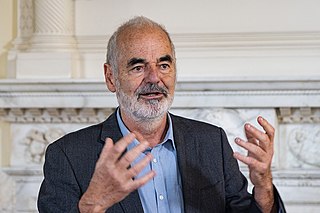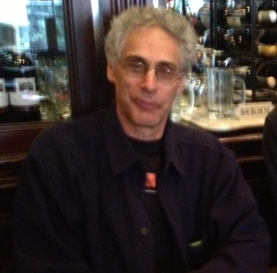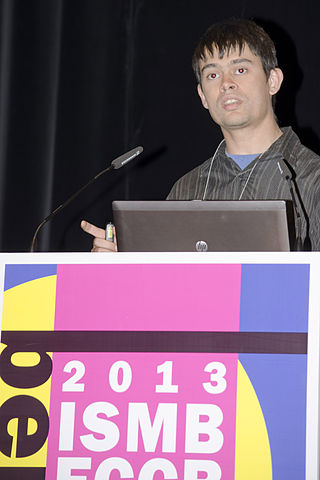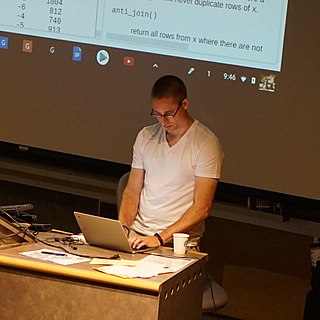Related Research Articles
Antioxidants are compounds that inhibit oxidation, a chemical reaction that can produce free radicals. Autoxidation leads to degradation of organic compounds, including living matter. Antioxidants are frequently added to industrial products, such as polymers, fuels, and lubricants, to extend their usable lifetimes. Food are also treated with antioxidants to forestall spoilage, in particular the rancidification of oils and fats. In cells, antioxidants such as glutathione, mycothiol or bacillithiol, and enzyme systems like superoxide dismutase, can prevent damage from oxidative stress.
Biostatistics is a branch of statistics that applies statistical methods to a wide range of topics in biology. It encompasses the design of biological experiments, the collection and analysis of data from those experiments and the interpretation of the results.

Peroxidases or peroxide reductases are a large group of enzymes which play a role in various biological processes. They are named after the fact that they commonly break up peroxides.
In statistical hypothesis testing, a result has statistical significance when a result at least as "extreme" would be very infrequent if the null hypothesis were true. More precisely, a study's defined significance level, denoted by , is the probability of the study rejecting the null hypothesis, given that the null hypothesis is true; and the p-value of a result, , is the probability of obtaining a result at least as extreme, given that the null hypothesis is true. The result is statistically significant, by the standards of the study, when . The significance level for a study is chosen before data collection, and is typically set to 5% or much lower—depending on the field of study.

Gallaudet University is a private federally chartered university in Washington, D.C., for the education of the deaf and hard of hearing. It was founded in 1864 as a grammar school for both deaf and blind children. It was the first school for the advanced education of the deaf and hard of hearing in the world and remains the only higher education institution in which all programs and services are specifically designed to accommodate deaf and hard of hearing students. Hearing students are admitted to the graduate school and a small number are also admitted as undergraduates each year. The university was named after Thomas Hopkins Gallaudet, a notable figure in the advancement of deaf education.

Sir David John Spiegelhalter is a British statistician and a Fellow of Churchill College, Cambridge. From 2007 to 2018 he was Winton Professor of the Public Understanding of Risk in the Statistical Laboratory at the University of Cambridge. Spiegelhalter is an ISI highly cited researcher.

Steven Henry Strogatz, born August 13, 1959, is an American mathematician and the Susan and Barton Winokur Distinguished Professor for the Public Understanding of Science and Mathematics at Cornell University. He is known for his work on nonlinear systems, including contributions to the study of synchronization in dynamical systems, and for his research in a variety of areas of applied mathematics, including mathematical biology and complex network theory.

Glutathione peroxidase 4, also known as GPX4, is an enzyme that in humans is encoded by the GPX4 gene. GPX4 is a phospholipid hydroperoxidase that protects cells against membrane lipid peroxidation.

Glutathione peroxidase 7 is an enzyme that in humans is encoded by the GPX7 gene.

Sander Greenland is an American statistician and epidemiologist with many contributions to statistical and epidemiologic methods including Bayesian and causal inference, bias analysis, and meta-analysis. His focus has been the extensions, limitations, and misuses of statistical methods in nonexperimental studies, especially in postmarketing surveillance of drugs, vaccines, and medical devices. He received honors Bachelor's and master's degrees in mathematics from the University of California, Berkeley, where he was Regent's and National Science Foundation Fellow in Mathematics, and then received Master's and Doctoral degrees in epidemiology from the University of California, Los Angeles (UCLA), where he was Regent's Fellow in Epidemiology. After serving as an assistant professor of biostatistics at Harvard, he joined the UCLA Epidemiology faculty in 1980 where he became Professor of Epidemiology in the Fielding School of Public Health in 1989, and Professor of Statistics in the UCLA College of Letters and Science in 1999. He moved to Emeritus status in 2012 and the following year he was awarded an honorary Doctor of Medicine by the University of Aarhus, Denmark.

Microsomal glutathione S-transferase 3 is an enzyme that in humans is encoded by the MGST3 gene.
Alice Yen-Ping Ting is Taiwanese-born American chemist. She is a professor of genetics, of biology, and by courtesy, of chemistry at Stanford University. She is also a Chan Zuckerberg Biohub investigator and a member of the National Academy of Sciences.
Marion Mckinley Bradford was an American scientist who developed and patented the Bradford protein assay, a method to quickly quantify the amount of protein in a sample. His paper describing the method is among the most cited scholarly articles of all time.

Glutathione peroxidase 5 (GPx-5), also known as epididymal secretory glutathione peroxidase is an enzyme that in humans is encoded by the GPX5 gene.

Gonçalo Rocha Abecasis is a Portuguese American biomedical researcher at the University of Michigan and was chair of the Department of Biostatistics in the School of Public Health. He leads a group at the Center for Statistical Genetics in the Department of Biostatistics, where he is also the Felix E. Moore Collegiate Professor of Biostatistics and director of the Michigan Genomic Initiative. His group develops statistical tools to analyze the genetics of human disease.
Marvin Zelen was Professor Emeritus of Biostatistics in the Department of Biostatistics at the Harvard T.H. Chan School of Public Health (HSPH), and Lemuel Shattuck Research Professor of Statistical Science. During the 1980s, Zelen chaired HSPH's Department of Biostatistics. Among colleagues in the field of statistics, he was widely known as a leader who shaped the discipline of biostatistics. He "transformed clinical trial research into a statistically sophisticated branch of medical research."

Jeffrey Tullis Leek is an American biostatistician and data scientist working as a Vice President, Chief Data Officer, and Professor at Fred Hutchinson Cancer Research Center. He is an author of the Simply Statistics blog, and runs several online courses through Coursera, as part of their Data Science Specialization. His most popular course is The Data Scientist's Toolbox, which he instructed along with Roger Peng and Brian Caffo. Leek is best known for his contributions to genomic data analysis and critical view of research and the accuracy of popular statistical methods.
Daniela M. Witten is an American biostatistician. She is a professor and the Dorothy Gilford Endowed Chair of Mathematical Statistics at the University of Washington. Her research investigates the use of machine learning to understand high-dimensional data.
Katherine Snowden Pollard is the Director of the Gladstone Institute of Data Science and Biotechnology and a professor at the University of California, San Francisco (UCSF). She is a Chan Zuckerberg Biohub Investigator. She was awarded Fellowship of the International Society for Computational Biology in 2020 and the American Institute for Medical and Biological Engineering in 2021 for outstanding contributions to computational biology and bioinformatics.
Eric R. Gamazon is a statistical geneticist in Vanderbilt University, with faculty affiliations in the Division of Genetic Medicine, Data Science Institute, and Center for Precision Medicine. He is a Life Member of Clare Hall, Cambridge University after election to a Visiting Fellowship (2018).
References
- ↑ Cherry, Nikki. "World of Wonder Seminar, April 2016 | Rochester Bridges to the Doctorate" . Retrieved 2020-03-25.
- ↑ "Regina Nuzzo | Department of Statistics". statistics.stanford.edu. Retrieved 2020-03-25.
- ↑ "About the Program". scicom.ucsc.edu. Retrieved 2020-03-25.
- ↑ "Biostatistics Seminar: Regina Nuzzo | Department of Biostatistics". www.biostat.washington.edu. Retrieved 2020-03-25.
- ↑ "Grand Rounds with Regina Nuzzo | UMD School of Public Health". sph.umd.edu. Retrieved 2020-03-25.
- ↑ "Regina Nuzzo | Department of Biostatistics | Harvard T.H. Chan School of Public Health". Department of Biostatistics. Retrieved 2020-03-31.
- ↑ "ASA Welcomes Regina Nuzzo as Senior Advisor for Statistics Communication and Media Innovation". www.amstat.org. Retrieved 2020-03-25.
- ↑ Nuzzo, Regina (2014-02-13). "Scientific method: Statistical errors". Nature News. 506 (7487): 150–152. Bibcode:2014Natur.506..150N. doi: 10.1038/506150a . PMID 24522584.
- ↑ "Standing Strong". www.cancertodaymag.org. Retrieved 2020-03-30.
- ↑ Nuzzo, Regina (November 1, 2014). "The Future of Election Forecasting". Scientific American. doi:10.1038/scientificamerican1114-21.
- ↑ Nuzzo, Regina (2014). "Regrown nerves boost bionic ears". Nature News. doi: 10.1038/nature.2014.15082 . S2CID 180772463.
- ↑ Nuzzo, Regina (2015-10-08). "How scientists fool themselves – and how they can stop". Nature News. 526 (7572): 182–185. Bibcode:2015Natur.526..182N. doi: 10.1038/526182a . PMID 26450039.
- ↑ Nuzzo, Regina (2014-08-28). "What Happens When Scientists Experiment on Themselves?". The Healthy. Retrieved 2020-03-30.
- ↑ Nuzzo, Regina (2018-10-12). "When courtroom science goes wrong — and how stats can fix it". Knowable Magazine. doi: 10.1146/knowable-101118-4 . S2CID 189573453.
- ↑ Bhamre, S.; Nuzzo, R. L.; Whitin, J. C.; Olshen, R. A.; Cohen, H. J. (August 2000). "Intracellular reduction of selenite into glutathione peroxidase. Evidence for involvement of NADPH and not glutathione as the reductant". Molecular and Cellular Biochemistry. 211 (1–2): 9–17. doi:10.1023/a:1007121506445. ISSN 0300-8177. PMID 11055542. S2CID 20643320.
- ↑ Dodson, Kelley M; Blanton, Susan H; Welch, Katherine O; Norris, Virginia W; Nuzzo, Regina L; Wegelin, Jacob A.; Marin, Ruth S; Nance, Walter E; Pandya, Arti; Arnos, Kathleen S (May 2011). "Vestibular Dysfunction in DFNB1 deafness". American Journal of Medical Genetics. Part A. 155 (5): 993–1000. doi:10.1002/ajmg.a.33828. ISSN 1552-4825. PMC 3080433 . PMID 21465647.